Magnetically Tunable Micro-Ring Resonators for Massive Magneto-Optical Modulation in Dense Wavelength Division Multiplexing Systems
Abstract
1. Introduction
2. Theory and Modeling
3. Results and Discussion
4. Conclusions
Author Contributions
Funding
Data Availability Statement
Acknowledgments
Conflicts of Interest
References
- Nagatsuma, T.; Ducournau, G.; Renaud, C.C. Advances in terahertz communications accelerated by photonics. Nat. Photonics 2016, 10, 371–379. [Google Scholar] [CrossRef]
- Ummethala, S.; Harter, T.; Koehnle, K.; Li, Z.; Muehlbrandt, S.; Kutuvantavida, Y.; Kemal, J.; Marin-Palomo, P.; Schaefer, J.; Tessmann, A.; et al. THz-to-optical conversion in wireless communications using an ultra-broadband plasmonic modulator. Nat. Photonics 2019, 13, 519–524. [Google Scholar] [CrossRef]
- Reed, G.T.; Mashanovich, G.; Gardes, F.Y.; Thomson, D.J. Silicon optical modulators. Nat. Photonics 2010, 4, 518–526. [Google Scholar] [CrossRef]
- Atabaki, A.H.; Moazeni, S.; Pavanello, F.; Gevorgyan, H.; Notaros, J.; Alloatti, L.; Wade, M.T.; Sun, C.; Kruger, S.A.; Meng, H.; et al. Integrating photonics with silicon nanoelectronics for the next generation of systems on a chip. Nature 2018, 556, 349–354. [Google Scholar] [CrossRef] [PubMed]
- Luo, L.W.; Ophir, N.; Chen, C.P.; Gabrielli, L.H.; Poitras, C.B.; Bergmen, K.; Lipson, M. WDM-compatible mode-division multiplexing on a silicon chip. Nat. Commun. 2014, 5, 3069. [Google Scholar] [CrossRef]
- Wang, X.; Kuang, K.; Wang, S.; Xu, S.; Liu, H.; Liu, G.N. Dynamic routing and spectrum allocation in elastic optical networks with mixed line rates. J. Opt. Commun. Netw. 2014, 6, 1115–1127. [Google Scholar] [CrossRef]
- Lee, Y.; Mukherjee, B. Traffic engineering in next-generation optical Networks. IEEE Commun. Surv. Tutorials 2004, 6, 16–33. [Google Scholar] [CrossRef]
- Little, B.E.; Chu, S.T.; Haus, H.A.; Foresi, J.; Laine, J. Microring resonator channel dropping filters. J. Light. Technol. 1997, 15, 998–1005. [Google Scholar] [CrossRef]
- Dingel, B. Multifunctional Optical Filter Using Direct-Coupled and Cross-Coupled All-Pass Filters. IEEE Photonics Technol. Lett. 2014, 26, 785–788. [Google Scholar] [CrossRef]
- Zhang, Z.; Yang, J.; He, X.; Han, Y.; Zhang, J.; Huang, J.; Chen, D. Plasmonic Filter and Demultiplexer Based on Square Ring Resonator. Appl. Sci. 2018, 8, 462. [Google Scholar] [CrossRef]
- Gad, M.; Ackert, J.; Yevick, D.; Chrostowski, L.; Jessop, P. Ring Resonator Wavelength Division Multiplexing Interleaver. J. Light. Technol. 2011, 29, 2102–2109. [Google Scholar] [CrossRef]
- Seifouri, M.; Fallahi, V.; Olyaee, S. Ultra-high-Q optical filter based on photonic crystal ring resonator. Photonic Netw. Commun. 2018, 35, 225–230. [Google Scholar] [CrossRef]
- Soref, R. The past, present, and future of silicon photonics. IEEE J. Sel. Top. Quantum Electron. 2006, 12, 1678–1687. [Google Scholar] [CrossRef]
- Kimerling, L.C.; Ahn, D.; Apsel, A.B.; Beals, M.; Carothers, D.; Chen, Y.K.; Conway, T.; Gill, D.M.; Grove, M.; Hong, C.Y.; et al. Electronic-photonic integrated circuits on the CMOS platform. In Proceedings of the Silicon Photonics, San Jose, CA, USA, 21–26 January 2006; Volume 6125, p. 612502. [Google Scholar]
- Miller, D.A.B. Optical interconnects to silicon. IEEE J. Sel. Top. Quantum Electron. 2000, 6, 1312–1317. [Google Scholar] [CrossRef]
- Jalali, B.; Fathpour, S. Silicon photonics. J. Light. Technol. 2006, 24, 4600–4615. [Google Scholar] [CrossRef]
- Janner, D.; Tulli, D.; García-Granda, M.; Belmonte, M.; Pruneri, V. Micro-structured integrated electro-optic LiNbO3 modulators. Laser Photonics Rev. 2009, 3, 301–313. [Google Scholar] [CrossRef]
- Luo, R.; Jiang, H.; Rogers, S.; Liang, H.; He, Y.; Lin, Q. On-chip second-harmonic generation and broadband parametric down-conversion in a lithium niobate microresonator. Opt. Express 2017, 25, 24531–24539. [Google Scholar] [CrossRef] [PubMed]
- Liljeberg, T. Silicon photonics and the future of optical connectivity in the data center. In Proceedings of the 2017 IEEE Optical Interconnects Conference (OI), Santa Fe, NM, USA, 5–7 June 2017; pp. 1–2. [Google Scholar]
- Yang, H.; Wang, Y.; Tiu, Z.C.; Tan, S.J.; Yuan, L.; Zhang, H. All-optical modulation technology based on 2D layered materials. Micromachines 2022, 13, 92. [Google Scholar] [CrossRef]
- Xu, Q.; Schmidt, B.; Pradhan, S.; Lipson, M. Micrometre-scale silicon electro-optic modulator. Nature 2005, 435, 325–327. [Google Scholar] [CrossRef]
- Sun, J.; Kumar, R.; Sakib, M.; Driscoll, J.B.; Jayatilleka, H.; Rong, H. A 128 Gb/s PAM4 Silicon Microring Modulator With Integrated Thermo-Optic Resonance Tuning. J. Light. Technol. 2019, 37, 110–115. [Google Scholar] [CrossRef]
- Petrosyan, D.; Malakyan, Y.P. Magneto-optical rotation and cross-phase modulation via coherently driven four-level atoms in a tripod configuration. Phys. Rev. A 2004, 70, 023822. [Google Scholar] [CrossRef]
- Jenkins, S.L.; Carothers, K.; Showghi, S.A.; Pyun, J.; Norwood, R.A. Magneto-optic Modulator Fabricated Using Polymer-Coated Magnetic Nanoparticles with 4.75dB Extinction Ratio. In Proceedings of the OSA Advanced Photonics Congress 2021, Optica Publishing Group, Washington, DC, USA, 26–29 July 2021; p. NoF2C.2. [Google Scholar]
- Hu, S.; Song, J.; Guo, Z.; Jiang, H.; Deng, F.; Dong, L.; Chen, H. Omnidirectional nonreciprocal absorber realized by the magneto-optical hypercrystal. Opt. Express 2022, 30, 12104–12119. [Google Scholar] [CrossRef] [PubMed]
- Dong, P.; Liao, S.; Feng, D.; Liang, H.; Zheng, D.; Shafiiha, R.; Kung, C.C.; Qian, W.; Li, G.; Zheng, X.; et al. Low Vpp, ultralow-energy, compact, high-speed silicon electro-optic modulator. Opt. Express 2009, 17, 22484–22490. [Google Scholar] [CrossRef] [PubMed]
- Phare, C.T.; Daniel Lee, Y.H.; Cardenas, J.; Lipson, M. Graphene electro-optic modulator with 30 GHz bandwidth. Nat. Photonics 2015, 9, 511–514. [Google Scholar] [CrossRef]
- Shekhawat, D.; Mehra, R. Design of Ultra-Compact and Highly-Sensitive Graphene Assisted Silicon Micro-Ring Resonator Modulator for Switching Applications. Silicon 2021, 14, 4383–4390. [Google Scholar] [CrossRef]
- Andrade, B.N.O.; Carvalho, W.O.F.; Beltrán-Mejía, F.; Mejía-Salazar, J.R. Polarization-Insensitive Optical Modulator Based on Single-Layer Graphene Sheets. IEEE Trans. Nanotechnol. 2021, 20, 883–888. [Google Scholar] [CrossRef]
- Chen, L.; Xu, Q.; Wood, M.G.; Reano, R.M. Hybrid silicon and lithium niobate electro-optical ring modulator. Optica 2014, 1, 112–118. [Google Scholar] [CrossRef]
- Padmaraju, K.; Chan, J.; Chen, L.; Lipson, M.; Bergman, K. Thermal stabilization of a microring modulator using feedback control. Opt. Express 2012, 20, 27999–28008. [Google Scholar] [CrossRef]
- Yamahara, H.; Feng, B.; Seki, M.; Adachi, M.; Sarker, M.S.; Takeda, T.; Kobayashi, M.; Ishikawa, R.; Ikuhara, Y.; Cho, Y.; et al. Flexoelectric nanodomains in rare-earth iron garnet thin films under strain gradient. Commun. Mater. 2021, 2, 95. [Google Scholar] [CrossRef]
- Mollaee, M.; Zhu, X.; Jenkins, S.; Zong, J.; Temyanko, E.; Norwood, R.; Chavez-Pirson, A.; Li, M.; Zelmon, D.; Peyghambarian, N. Magneto-optical properties of highly Dy3+ doped multicomponent glasses. Opt. Express 2020, 28, 11789–11796. [Google Scholar] [CrossRef]
- Zhang, Y.; Du, Q.; Wang, C.; Fakhrul, T.; Liu, S.; Deng, L.; Huang, D.; Pintus, P.; Bowers, J.; Ross, C.A.; et al. Monolithic integration of broadband optical isolators for polarization-diverse silicon photonics. Optica 2019, 6, 473–478. [Google Scholar] [CrossRef]
- Pintus, P.; Huang, D.; Morton, P.A.; Shoji, Y.; Mizumoto, T.; Bowers, J.E. Broadband TE Optical Isolators and Circulators in Silicon Photonics Through Ce:YIG Bonding. J. Light. Technol. 2019, 37, 1463–1473. [Google Scholar] [CrossRef]
- Murai, T.; Shoji, Y.; Nishiyama, N.; Mizumoto, T. Nonvolatile magneto-optical switches integrated with a magnet stripe array. Opt. Express 2020, 28, 31675–31685. [Google Scholar] [CrossRef] [PubMed]
- Carvalho, W.O.F.; Mejía-Salazar, J.R. Magneto-optical micro-ring resonators for dynamic tuning of add/drop channels in dense wavelength division multiplexing applications. Opt. Lett. 2021, 46, 2396–2399. [Google Scholar] [CrossRef]
- Zhang, Y.; Deng, L.; Bi, L. Silicon Integrated Dysprosium Substituted Ce:YIG Thin Films for Integrated Optical Isolator Applications. In Proceedings of the 2019 Asia Communications and Photonics Conference (ACP), Chengdu, China, 2–5 November 2019; pp. 1–2. [Google Scholar]
- Du, Q.; Wang, C.; Zhang, Y.; Zhang, Y.; Fakhrul, T.; Zhang, W.; Gonçalves, C.; Blanco, C.; Richardson, K.; Deng, L.; et al. Monolithic On-chip Magneto-optical Isolator with 3 dB Insertion Loss and 40 dB Isolation Ratio. ACS Photonics 2018, 5, 5010–5016. [Google Scholar] [CrossRef]
- Bogaerts, W.; De Heyn, P.; Van Vaerenbergh, T.; De Vos, K.; Kumar Selvaraja, S.; Claes, T.; Dumon, P.; Bienstman, P.; Van Thourhout, D.; Baets, R. Silicon microring resonators. Laser Photonics Rev. 2012, 6, 47–73. [Google Scholar] [CrossRef]
- Mulyanti, B.; Menon, P.S.; Shaari, S.; Hariyadi, T.; Hasanah, L.; Haroon, H. Design and optimization of coupled Microring Resonators (MRRs) in silicon-on-insulator. Sains Malays. 2014, 43, 247–252. [Google Scholar]
- Floess, D.; Giessen, H. Nonreciprocal hybrid magnetoplasmonics. Rep. Prog. Phys. 2018, 81, 116401. [Google Scholar] [CrossRef]
- Onbasli, M.C.; Beran, L.; Zahradník, M.; Kučera, M.; Antoš, R.; Mistrík, J.; Dionne, G.F.; Veis, M.; Ross, C.A. Optical and magneto-optical behavior of Cerium Yttrium Iron Garnet thin films at wavelengths of 200–1770 nm. Sci. Rep. 2016, 6, 23640. [Google Scholar] [CrossRef]
- Li, H.H. Refractive index of silicon and germanium and its wavelength and temperature derivatives. J. Phys. Chem. Ref. Data 1980, 9, 561–658. [Google Scholar] [CrossRef]
- Malitson, I.H. Interspecimen comparison of the refractive index of fused silica. J. Opt. Soc. Am. 1965, 55, 1205–1209. [Google Scholar] [CrossRef]
- Senior, J.M.; Jamro, M.Y. Optical Fiber Communications: Principles and Practice; Pearson Education: London, UK, 2009. [Google Scholar]
- Yuan, Y.; Sorin, W.V.; Huang, Z.; Zeng, X.; Liang, D.; Kumar, A.; Palermo, S.; Fiorentino, M.; Beausoleil, R.G. A 100 Gb/s PAM4 Two-Segment Silicon Microring Resonator Modulator Using a Standard Foundry Process. ACS Photonics 2022, 9, 1165–1171. [Google Scholar] [CrossRef]
- Palermo, S.; Yu, K.; Roshan-Zamir, A.; Wang, B.; Li, C.; Seyedi, M.A.; Fiorentino, M.; Beausoleil, R. PAM4 silicon photonic microring resonator-based transceiver circuits. In Proceedings of the Optical Interconnects XVII. International Society for Optics and Photonics, SPIE, San Francisco, CA, USA, 28 January–2 February 2017; Volume 10109, pp. 97–103. [Google Scholar]
- Zhang, Y.; Zhang, H.; Li, M.; Feng, P.; Wang, L.; Xiao, X.; Yu, S. 200 Gbit/s Optical PAM4 Modulation Based on Silicon Microring Modulator. In Proceedings of the 2020 European Conference on Optical Communications (ECOC), Brussels, Belgium, 6–10 December 2020; pp. 1–4. [Google Scholar]
- Mizumoto, T.; Baets, R.; Bowers, J.E. Optical nonreciprocal devices for silicon photonics using wafer-bonded magneto-optical garnet materials. MRS Bull. 2018, 43, 419–424. [Google Scholar] [CrossRef]
- ITU-T. Spectral Grids for WDM Applications: DWDM Frequency Grid. 2020. Available online: https://www.itu.int/rec/T-REC-G.694.1/ (accessed on 28 September 2022).
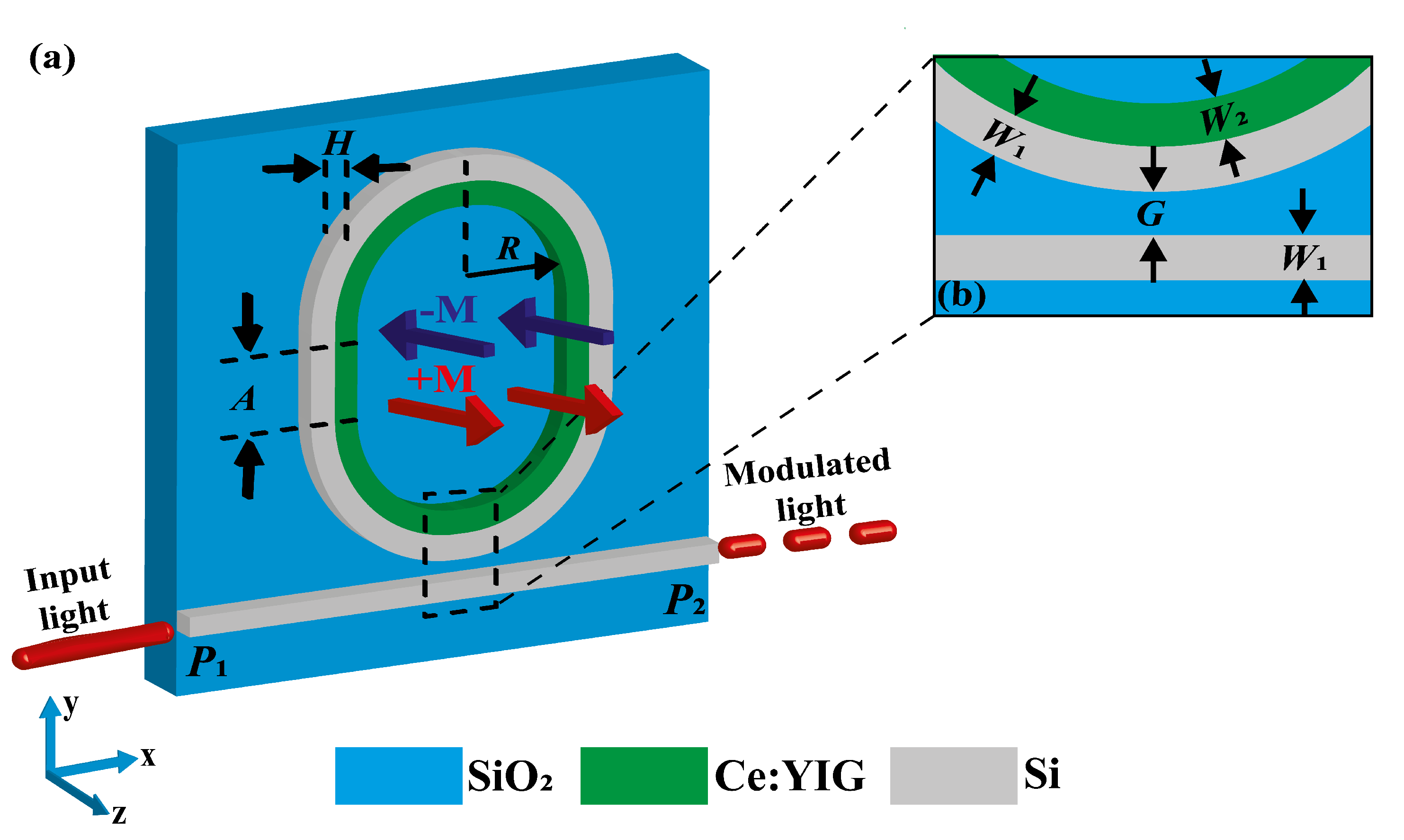
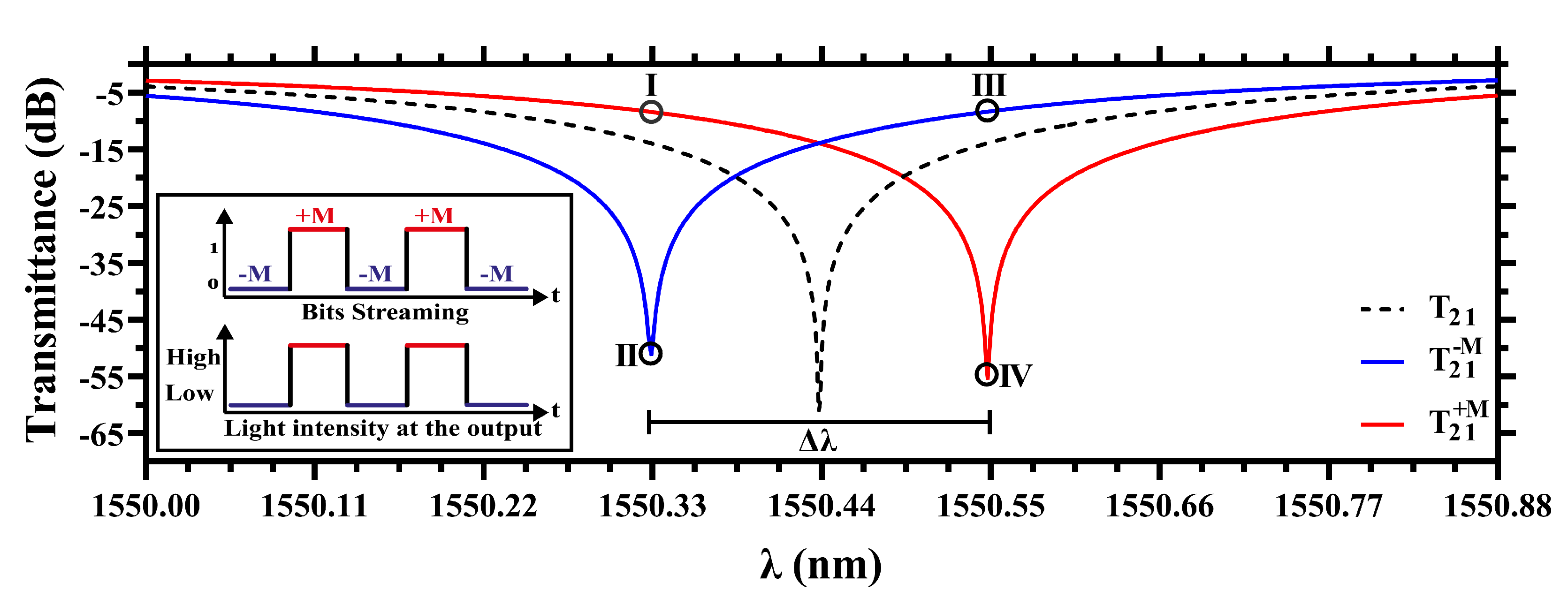
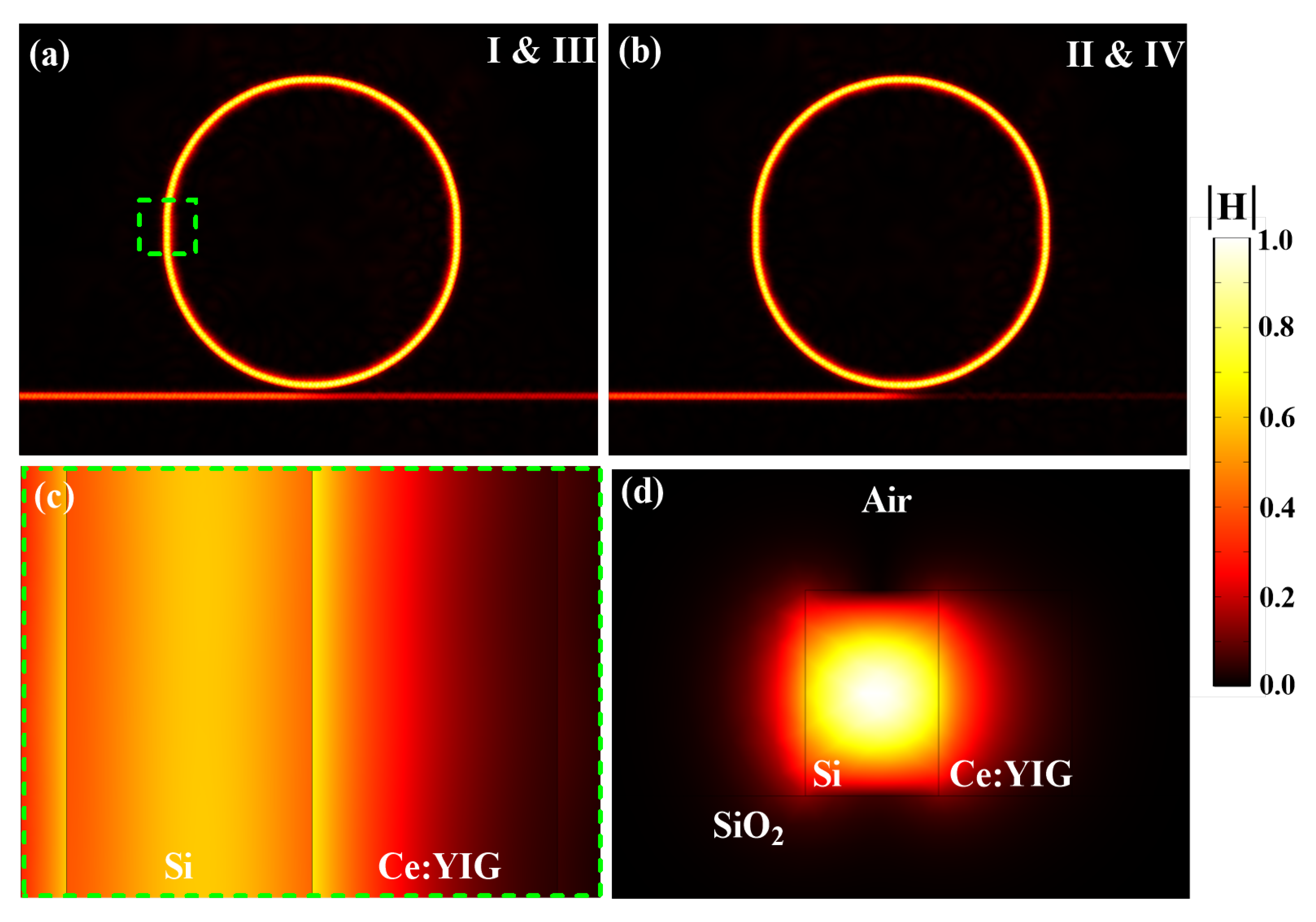
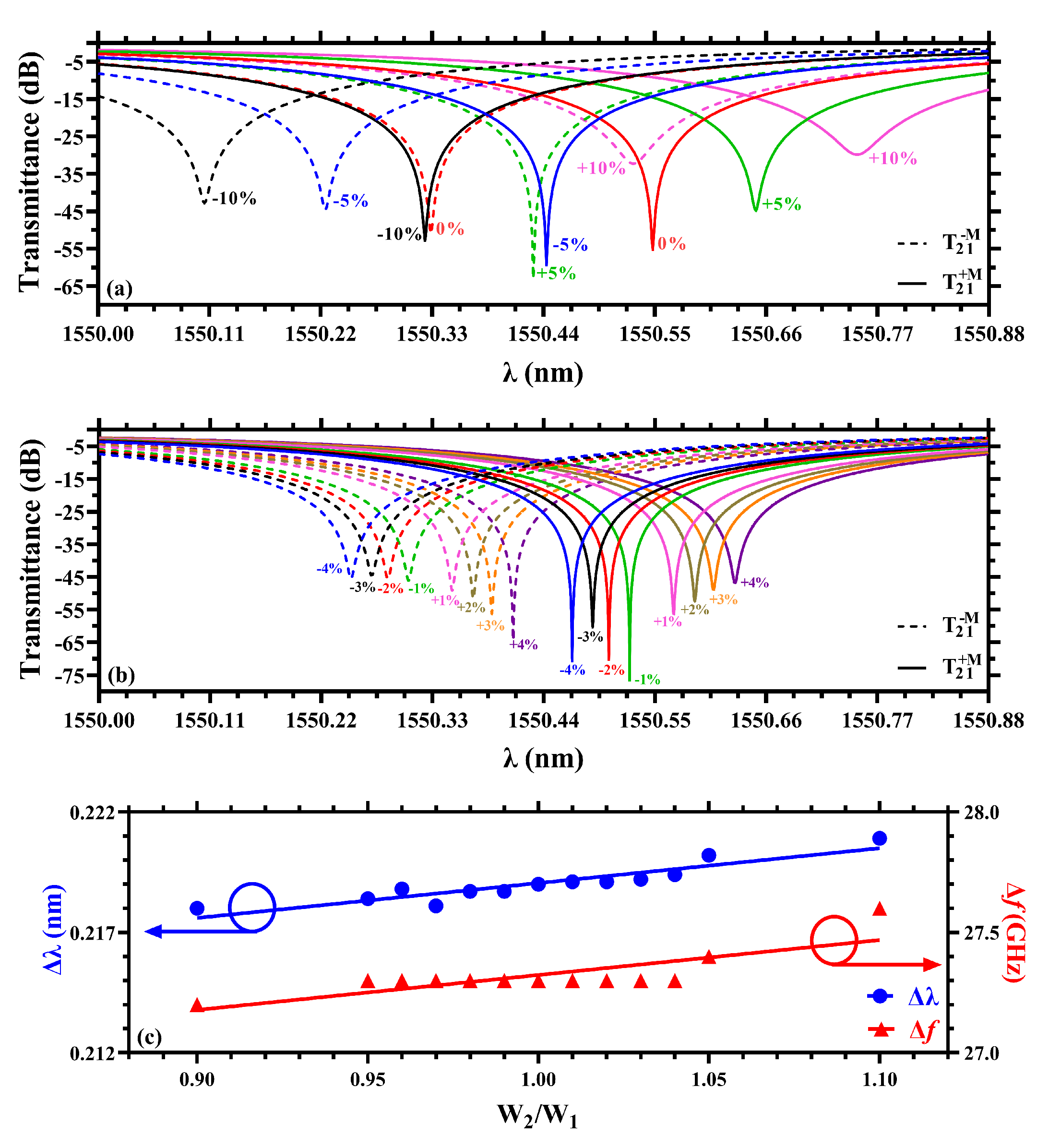
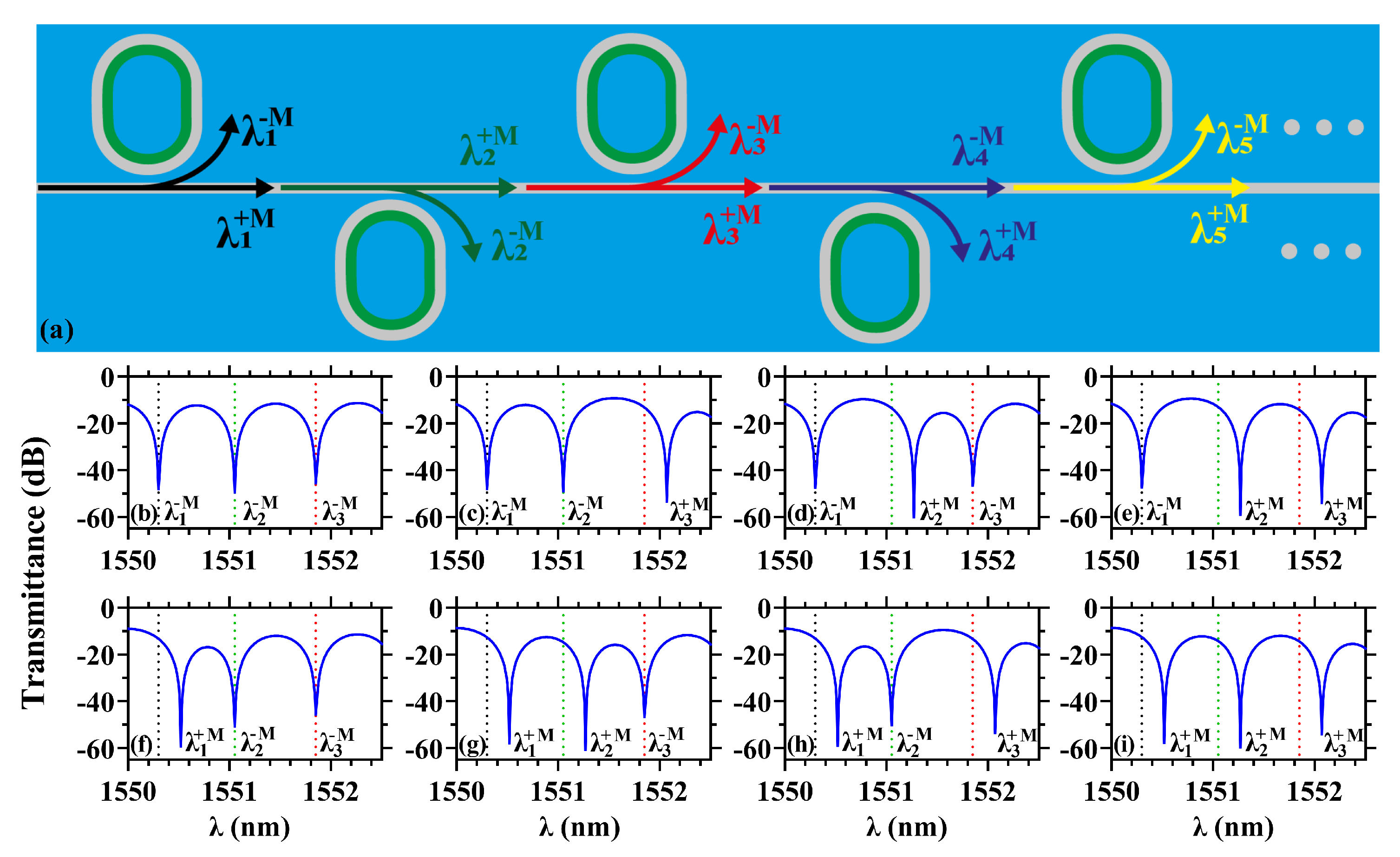
| Ref. | Waveguide | Substrate | Materials for Tunability | Effect | Ring Radius | IL | ER | |
|---|---|---|---|---|---|---|---|---|
| [47] | Si | Si (CMOS) | p-Si and n-Si | EO | 12 m | 1 dB | 2.4 dB | 0.06 nm |
| [28] | Si | SiO | Graphene | EO | 3 m | 1.54 dB | 10.2 dB | 6 nm |
| [27] | SiN | SiO | Graphene | EO | 40 m | 6 dB | 28 dB | 0.2 nm |
| [30] | LiNbO and Si | SiO | aluminum | EO | 15 m | 4.3 dB | 5.6 dB | 0.066 nm |
| [48] | Si | Si (CMOS) | p-Si and n-Si | EO | 8 m | 3–6 dB | 7.78 dB | 0.02 nm |
| [22] | Si | SiO | p-Si and n-Si | TO | 10 m | 4–14 dB | 20 dB | 0.05 nm |
| [49] | Si | Si (CMOS) | TiN | TO | 8 m | 13 dB | 25 dB | 0.6 nm |
| [24] | SiN | SiO | Cobalt nanoparticles | MO | 10 m | 0.6 dB | 4.75 dB | - |
| This work | Si | SiO | Ce:YIG | MO | 5.6 m | 5 dB | 46.7 dB | 0.22 nm |
| A (nm) | (nm) | (nm) | (nm) | (nm) | IL (dB) | ER (dB) |
|---|---|---|---|---|---|---|
| 561 | 1547.91 | 1548.02 | 1548.13 | 0.22 | 10.95 | 38.85 |
| 574 | 1548.73 | 1548.84 | 1548.95 | 0.22 | 10.76 | 43.31 |
| 587 | 1549.54 | 1549.64 | 1549.76 | 0.22 | 11.26 | 42.44 |
| 600 | 1550.33 | 1550.44 | 1550.55 | 0.22 | 12.34 | 46.70 |
| 613 | 1551.10 | 1551.21 | 1551.32 | 0.22 | 11.60 | 35.60 |
| 626 | 1551.87 | 1551.98 | 1552.09 | 0.22 | 11.37 | 33.47 |
| 639 | 1552.75 | 1552.86 | 1552.97 | 0.22 | 11.83 | 41.19 |
| 652 | 1553.54 | 1553.65 | 1553.76 | 0.22 | 11.81 | 35.25 |
| 665 | 1554.33 | 1554.44 | 1554.55 | 0.22 | 11.25 | 29.42 |
| 678 | 1555.16 | 1555.28 | 1555.39 | 0.23 | 10.92 | 24.76 |
Publisher’s Note: MDPI stays neutral with regard to jurisdictional claims in published maps and institutional affiliations. |
© 2022 by the authors. Licensee MDPI, Basel, Switzerland. This article is an open access article distributed under the terms and conditions of the Creative Commons Attribution (CC BY) license (https://creativecommons.org/licenses/by/4.0/).
Share and Cite
Neto, J.V.S.; Carvalho, W.O.F.; Mejía-Salazar, J.R. Magnetically Tunable Micro-Ring Resonators for Massive Magneto-Optical Modulation in Dense Wavelength Division Multiplexing Systems. Sensors 2022, 22, 8163. https://doi.org/10.3390/s22218163
Neto JVS, Carvalho WOF, Mejía-Salazar JR. Magnetically Tunable Micro-Ring Resonators for Massive Magneto-Optical Modulation in Dense Wavelength Division Multiplexing Systems. Sensors. 2022; 22(21):8163. https://doi.org/10.3390/s22218163
Chicago/Turabian StyleNeto, Josino Villela S., William O. F. Carvalho, and Jorge Ricardo Mejía-Salazar. 2022. "Magnetically Tunable Micro-Ring Resonators for Massive Magneto-Optical Modulation in Dense Wavelength Division Multiplexing Systems" Sensors 22, no. 21: 8163. https://doi.org/10.3390/s22218163
APA StyleNeto, J. V. S., Carvalho, W. O. F., & Mejía-Salazar, J. R. (2022). Magnetically Tunable Micro-Ring Resonators for Massive Magneto-Optical Modulation in Dense Wavelength Division Multiplexing Systems. Sensors, 22(21), 8163. https://doi.org/10.3390/s22218163







